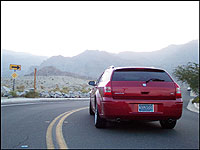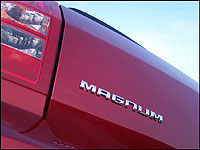The Magnum loves to be pushed, eating up corner after corner, a little tire squeal followed by responsive, predictable handling no matter how hard it's driven. Considering the car's considerable weight, I expected either rear-wheel drive induced oversteer (when the rear end of the car looses grip and swings outward), or for safety's sake, calibrated understeer (when the front end "purposely" looses grip and pushes outward away from the desired direction of the turn, the better of two evils for average driving skills). Much to my surprise neither occurred.
 |
| Like many sport and luxury cars, the Magnum features the high-end ESP stability and traction control system. (Photo: Trevor Hofmann, Canadian Auto Press) |
The high-end ESP stability and traction control system, yes the same outsourced safety net that many $50K to $100K luxury and sports models include as part of their safety systems, keeps the rear wheels in check when they begin to slip. The way Dodge has dialed in just enough protection, without negatively intruding on the Magnum's at-the-limit driving pleasure, is especially impressive. I could feel ESP saving me from an over-ambitious outside passing maneuver, a very good thing, but it doesn't impede forward progress for a millisecond. Again, the word seamless is the best descriptive.
 |
| Despite my efforts, I was unable to find the Magnum's breaking point in the corners. (Photo: Trevor Hofmann, Canadian Auto Press) |
In case you question the validity of such systems, a recent study using the National Advanced Driving Simulator (NADS) owned by the National Highway Traffic Safety Administration (NHTSA) and operated by The University of Iowa, concluded that ESP can reduce the risk of losing control by as much as 88 percent, which translates into an increase of 34 percent in the number of drivers who maintained control of their vehicles with the ESP system activated. Sounds like a worthwhile investment on Chrysler Group's part.
As expected most cars equipped with ESP will react in a similar fashion, if not necessarily as well executed as the Dodge. What happens next is what truly won me over. When the rear wheels remain on their desired trajectory, the only place left for the car's mass to go is forward, usually resulting in the front tires breaking contact with the road surface and "plowing" outward toward the opposing lane - not a good thing. Just when I expected the Magnum to do just that, somehow by what can only be described as a miracle of modern engineering, the car stayed in its place and found its way around the curve with all four wheels on the right side of the two yellow lines. And it wasn't just a one time fluke of nature. I tested its capabilities over and over, at higher and higher speeds with the same result. I'm sure that there's a breaking point somewhere, as physics are physics and natural laws can't be completely broken, but I highly doubt even skilled drivers will test the Magnum to the levels I experienced.

